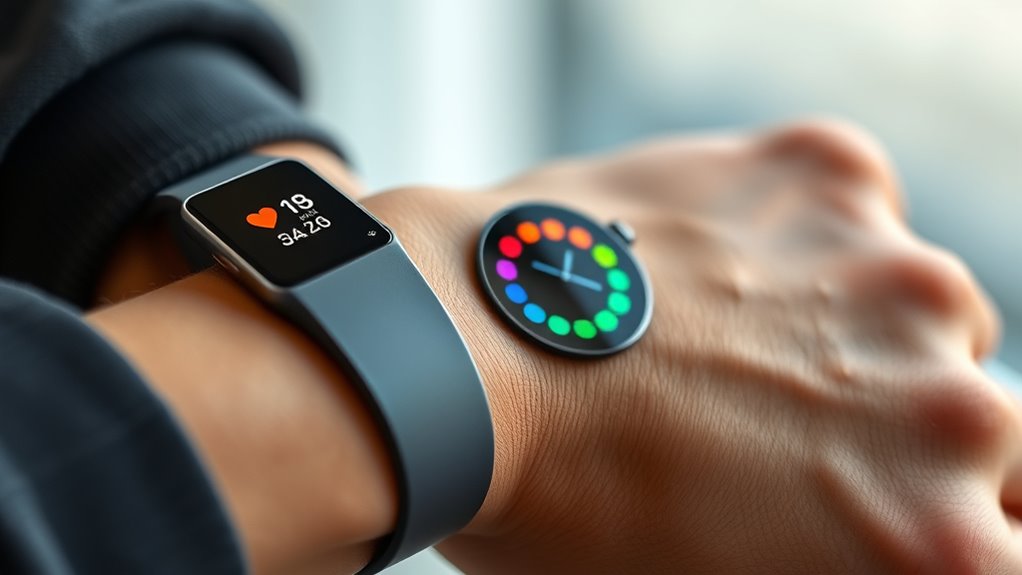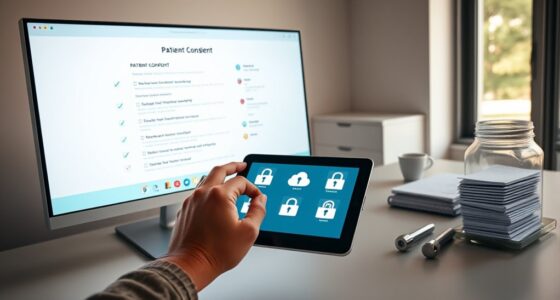Wearable devices document your health data by tracking steps, heart rate, sleep, and more, helping you understand your habits and spot potential issues early. They collect real-time, accurate information through high-quality sensors and often sync seamlessly with other devices for complete health profiles. Protecting this sensitive data is vital, so encryption and privacy controls matter. To learn how these devices balance technology and security for your health journey, keep exploring the details ahead.
Key Takeaways
- Wearable devices collect real-time health data such as heart rate, steps, and sleep patterns using integrated sensors.
- Accurate sensors are essential for reliable data interpretation and meaningful health insights.
- Data privacy measures like encryption and user controls protect sensitive health information stored and shared by devices.
- Seamless interoperability enables data sharing across different devices and platforms, enhancing comprehensive health analysis.
- Proper data documentation and interpretation support early detection, personalized health management, and informed decision-making.

Have you ever wondered how wearable devices are transforming everyday life? These sleek gadgets do more than track your steps or monitor your heart rate; they’re becoming sophisticated tools that document and interpret your health data in real time. As you wear a fitness tracker or smartwatch, it continuously collects a wide array of information—everything from your sleep patterns to your calorie intake. This constant data collection helps you understand your habits better and even spot potential health issues before they become serious. But as impressive as these devices are, they also raise important questions about data privacy and device interoperability.
When it comes to data privacy, you need to be aware of how your health information is stored, shared, and protected. While most wearable manufacturers implement security measures, the sheer amount of sensitive health data being transmitted and stored raises concerns about unauthorized access or breaches. You should always review the privacy policies of your devices and ensure they offer robust encryption and user controls. It’s crucial to understand who has access to your data and how it might be used, especially if it’s shared with third-party apps or healthcare providers. Safeguarding your health information isn’t just about avoiding privacy invasions; it’s about maintaining trust in the technology that’s becoming an integral part of your life.
Device interoperability is another critical aspect of wearable health technology. Many users own multiple devices from different brands, each with its own ecosystem and data format. Confirming these devices can communicate seamlessly is indispensable for creating a complete health profile. When your smartwatch, fitness tracker, and even your smart scales can sync effortlessly, you get a more complete picture of your health without manual data entry or complicated integrations. This interoperability allows you to leverage insights from various sources, making it easier to track progress, set goals, and share data with healthcare professionals. It also helps manufacturers develop better, more integrated products that work smoothly together, enhancing user experience and trust. Additionally, high-quality sensors in these devices play a vital role in ensuring accurate data collection, which is essential for reliable health interpretation.
Ultimately, the power of wearable devices in documenting and interpreting health data hinges on balancing innovation with responsibility. By paying attention to data privacy and ensuring device interoperability, you can maximize the benefits of these devices while safeguarding your personal information. As technology advances, it’s up to you to stay informed and proactive about protecting your health data and making the most of what wearable devices have to offer. These tools can be game-changers, but only if you understand the importance of security and compatibility in your health journey.
Frequently Asked Questions
How Accurate Are Wearable Devices in Measuring Health Metrics?
Wearable devices generally provide good data accuracy, but their precision depends on proper sensor calibration. If sensors are well-calibrated, you can trust the health metrics they record, like heart rate or activity levels. However, factors like device placement and individual differences can still affect accuracy. Always make certain your device is regularly calibrated and updated for the most reliable data, helping you make informed health decisions.
What Privacy Measures Protect My Health Data From Wearable Devices?
Your health data is protected like a locked treasure chest. Wearable device companies use data encryption to safeguard your information, making it unreadable to outsiders. They also implement strict access controls, so only authorized individuals can view your data. These measures help ensure your personal health details stay private and safe from misuse or unauthorized access, giving you peace of mind while you focus on your wellness journey.
Can Wearable Devices Detect Early Signs of Health Issues?
Wearable devices can detect early signs of health issues through continuous symptom monitoring, alerting you to potential problems before they worsen. They track essential signs like heart rate, oxygen levels, and activity patterns, helping with early detection of conditions such as arrhythmias or respiratory issues. By providing real-time data, these devices empower you to seek timely medical advice, improving your overall health management and preventing more serious complications.
How Long Do Wearable Device Batteries Typically Last?
Like a knight’s trusty steed from medieval tales, your wearable’s battery longevity varies, but most last between 24 to 7 days. You’ll need to check your device’s charging frequency, which depends on usage and features. Some models with advanced sensors may need more frequent charging, while simpler ones last longer. Keep an eye on the battery indicator to avoid unexpected power depletion, ensuring continuous health tracking.
Are Wearable Devices Suitable for Children or Elderly Users?
Wearable devices can be suitable for children and the elderly if designed with safety and usability in mind. For children, focus on child safety features like secure data sharing and durable design. For the elderly, look for devices offering easy usability, clear displays, and comfort. Always guarantee the device fits their specific needs and consult healthcare providers to choose the best option. Properly selected wearables can enhance health monitoring for both groups.
Conclusion
Wearable devices transform how you monitor your health, providing real-time insights that empower you to make informed decisions. Imagine tracking your heart rate during a marathon and catching early signs of fatigue, prompting you to rest and recover. These devices don’t just collect data—they help you understand your body better. As technology advances, embracing wearables can lead to healthier, more proactive lifestyles, keeping you one step ahead of potential health issues.








